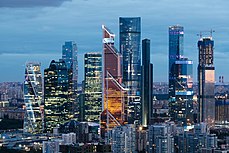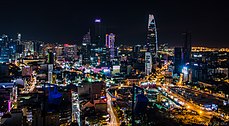Urbanization

Urbanization (or urbanisation in British English) is the population shift from rural to urban areas, the corresponding decrease in the proportion of people living in rural areas, and the ways in which societies adapt to this change. It can also mean population growth in urban areas instead of rural ones.[1] It is predominantly the process by which towns and cities are formed and become larger as more people begin living and working in central areas.[2]
Although the two concepts are sometimes used interchangeably, urbanization should be distinguished from
Urbanization is relevant to a range of disciplines, including
Urbanization is not merely a modern phenomenon, but a rapid and historic transformation of human
History
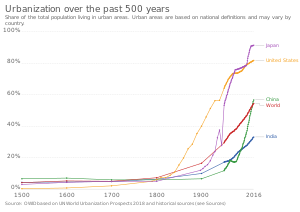
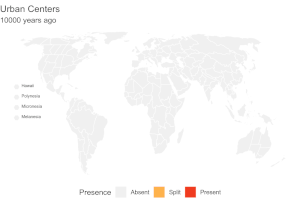
From the development of the earliest cities in
With the onset of the
As labourers were freed up from working the land due to higher
Urbanization rapidly spread across the
Yale University in June 2016 published urbanization data from the time period 3700 BC to 2000 AD, the data was used to make a video showing the development of cities on the world during the time period.[18][19][20] The origins and spread of urban centers around the world were also mapped by archaeologists.[13]
Causes
This section needs additional citations for verification. (June 2021) |

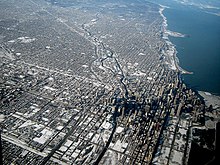
Urbanization occurs either organically or planned as a result of individual, collective and state action. Living in a city can be culturally and economically beneficial since it can provide greater opportunities for access to the labour market, better education, housing, and safety conditions, and reduce the time and expense of commuting and transportation. Conditions like density, proximity, diversity, and marketplace competition are elements of an urban environment that deemed beneficial. However, there are also harmful social phenomena that arise: alienation, stress, increased cost of living, and mass marginalization that are connected to an urban way of living.[citation needed] Suburbanization, which is happening in the cities of the largest developing countries, may be regarded as an attempt to balance these harmful aspects of urban life while still allowing access to the large extent of shared resources.[citation needed]
In cities, money, services, wealth and opportunities are centralized. Many rural inhabitants come to the city to seek their fortune and alter their social position. Businesses, which provide jobs and exchange capital, are more concentrated in urban areas. Whether the source is trade or tourism, it is also through the ports or banking systems, commonly located in cities, that foreign money flows into a country.
Many people move into cities for economic opportunities, but this does not fully explain the very high recent urbanization rates in places like China and India. Rural flight is a contributing factor to urbanization. In rural areas, often on small family farms or collective farms in villages, it has historically been difficult to access manufactured goods, though the relative overall quality of life is very subjective, and may certainly surpass that of the city. Farm living has always been susceptible to unpredictable environmental conditions, and in times of drought, flood or pestilence, survival may become extremely problematic.
Thai farmers are seen as poor, stupid, and unhealthy. As young people flee the farms, the values and knowledge of rice farming and the countryside are fading, including the tradition of long kek, helping neighbours plant, harvest, or build a house. We are losing what we call Thai-ness, the values of being kind, helping each other, having mercy and gratefulness.
– Iam Thongdee, Professor of Humanities, Mahidol University in Bangkok[22]
In a New York Times article concerning the acute migration away from farming in Thailand, life as a farmer was described as "hot and exhausting". "Everyone says the farmer works the hardest but gets the least amount of money". In an effort to counter this impression, the Agriculture Department of Thailand is seeking to promote the impression that farming is "honorable and secure".[22]
However, in Thailand, urbanization has also resulted in massive increases in problems such as obesity. Shifting from a rural environment to an urbanized community also caused a transition to a diet that was mainly carbohydrate-based to a diet higher in fat and sugar, consequently causing a rise in obesity.
These are the costs of participating in the urban economy. Your increased income is canceled out by increased expenditure. In the end, you have even less left for food.
– Madhura Swaminathan, economist at Kolkata’s Indian Statistical Institute[24]
Particularly in the developing world, conflict over land rights due to the effects of
Cities offer a larger variety of services, including specialist services not found in rural areas. These services require workers, resulting in more numerous and varied job opportunities. Elderly people may be forced to move to cities where there are doctors and hospitals that can cater to their health needs. Varied and high-quality educational opportunities are another factor in urban migration, as well as the opportunity to join, develop, and seek out social communities.
Urbanization also creates opportunities for women that are not available in rural areas. This creates a gender-related transformation where women are engaged in paid employment and have access to education. This may cause fertility to decline. However, women are sometimes still at a disadvantage due to their unequal position in the labour market, their inability to secure assets independently from male relatives and exposure to violence.[25]
People in cities are more productive than in rural areas. An important question is whether this is due to agglomeration effects or whether cities simply attract those who are more productive. Urban geographers have shown that there exists a large productivity gain due to locating in dense agglomerations.[26] It is thus possible that agents locate in cities in order to benefit from these agglomeration effects.[27]
Dominant conurbation
The dominant
Though Greater Busan-Ulsan (15%, 8 million) and Greater Osaka (14%, 18 million) dominate their respective countries, their populations are moving to their even more dominant rivals, Seoul and Tokyo respectively.[29]
Economic effects
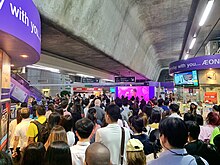

As cities develop, costs will skyrocket. This often takes the working class out of the market, including officials and employees of the local districts. For example, Eric Hobsbawm's book The age of revolution: 1789–1848 (published 1962 and 2005) chapter 11, stated "Urban development in our period was a gigantic process of class segregation, which pushed the new labouring poor into great morasses of misery outside the centres of government, business, and the newly specialized residential areas of the bourgeoisie. The almost universal European division into a 'good' west end and a 'poor' east end of large cities developed in this period." This is probably caused by the south-west wind which carries coal smoke and other pollutants down, making the western edges of towns better than the eastern ones.[30]
Similar problems now affect less developed countries, as rapid development of cities makes inequality worse. The drive to grow quickly and be efficient can lead to less fair urban development. Think tanks such as the
Urban problems, along with developments in their facilities, are also fuelling suburb development trends in less developed nations, though the trend for core cities in said nations tends to continue to become ever denser. Development of cities is often viewed negatively, but there are positives in cutting down on transport costs, creating new job opportunities, providing education and housing, and transportation. Living in cities permits individuals and families to make use of their closeness to workplaces and diversity.[33][34][35][36] While cities have more varied markets and goods than rural areas, facility congestion, domination of one group, high overhead and rental costs, and the inconvenience of trips across them frequently combine to make marketplace competition harsher in cities than in rural areas.[citation needed]
In many developing countries where economies are growing, the growth is often random and based on a small number of industries. Youths in these nations lack access to financial services and business advisory services, cannot get credit to start a business, and have no entrepreneurial skills. Therefore, they cannot seize opportunities in these industries. Making sure adolescents have access to excellent schools and infrastructure to work in such industries and improve schools is compulsory to promote a fair society.[37]
Environmental effects
| Part of a series on |
| Pollution |
|---|
 |
Furthermore, urbanization improves environmental eminence through superior facilities and standards in urban areas as compared to rural areas. Lastly, urbanization curbs pollution emissions by increasing innovations.
However, existing infrastructure and city planning practices are not sustainable.[41] In July 2013 a report issued by the United Nations Department of Economic and Social Affairs[42] warned that with 2.4 billion more people by 2050, the amount of food produced will have to increase by 70%, straining food resources, especially in countries already facing food insecurity due to changing environmental conditions. The mix of changing environmental conditions and the growing population of urban regions, according to UN experts, will strain basic sanitation systems and health care, and potentially cause a humanitarian and environmental disaster.[43]
Urban heat island
Urban heat islands have become a growing concern over the years. An urban heat island is formed when industrial areas absorb and retain heat. Much of the solar energy reaching rural areas is used to evaporate water from plants and soil. In cities, there are less vegetation and exposed soil. Most of the sun's energy is instead absorbed by buildings and asphalt; leading to higher surface temperatures. Vehicles, factories, and heating and cooling units in factories and homes release even more heat.[44] As a result, cities are often 1 to 3 °C (1.8 to 5.4 °F) warmer than other areas near them.[45] Urban heat islands also make the soil drier and absorb less carbon dioxide from emissions.[46]
Water quality
Urban runoff, polluted water created by rainfall on impervious surfaces, is a common effect of urbanization. Precipitation from rooftops, roads, parking lots and sidewalks flows to storm drains, instead of percolating into groundwater. The contaminated stormwater in the drains is typically untreated and flows to nearby streams, rivers or coastal bays.[47]
Eutrophication in water bodies is another effect large populations in cities have on the environment. When rain occurs in these large cities, it filters CO2 and other pollutants in the air onto the ground. These chemicals are washed directly into rivers, streams, and oceans, making water worse and damaging ecosystems in them.[48]
Eutrophication is a process which causes low levels of oxygen in water and algal blooms that may harm aquatic life.[49] Harmful algal blooms make dangerous toxins. They live best in nitrogen- and phosphorus-rich places which include the oceans contaminated by the aforementioned chemicals.[50] In these ideal conditions, they choke surface water, blocking sunlight and nutrients from other life forms. Overgrowth of algal blooms makes water worse overall and disrupts the natural balance of aquatic ecosystems. Furthermore, as algal blooms die, CO2 is produced. This makes the ocean more acidic, a process called acidification.[51]
The ocean's surface can absorb CO2 from the Earth's atmosphere as emissions increase with the rise in urban development. In fact, the ocean absorbs a quarter of the CO2 produced by humans.[52] This helps to lessen the harmful effects of greenhouse gases. But it also makes the ocean more acidic.[53] A drop in pH the prevents the proper formation of calcium carbonate, which sea creatures need to build or keep shells or skeletons.[54][52] This is especially true for many species of molluscs and coral. However, some species have been able to thrive in a more acidic environment.[55]
Food waste
Rapid growth of communities creates new challenges in the developed world and one such challenge is an increase in
Waste management systems vary on all scales from global to local and can also be influenced by lifestyle. Waste management was not a primary concern until after the Industrial Revolution. As urban areas continued to grow along with the human population, proper management of solid waste became an apparent concern. To address these concerns, local governments sought solutions with the lowest economic impacts which meant implementing technical solutions at the very last stage of the process.[63] Current waste management reflects these economically motivated solutions, such as incineration or unregulated landfills. Yet, a growing increase for addressing other areas of life cycle consumption has occurred from initial stage reduction to heat recovery and recycling of materials.[63] For example, concerns for mass consumption and fast fashion have moved to the forefront of the urban consumers’ priorities. Aside from environmental concerns (e.g. climate change effects), other urban concerns for waste management are public health and land access.
Habitat fragmentation
Urbanization can have a large effect on biodiversity by causing a division of habitats and thereby alienation of species, a process known as
Depending on the various factors, such as level of urbanization, both increases or decreases in "species richness" can be seen.[69][70] This means that urbanization may be detrimental to one species but also help facilitate the growth of others. In instances of housing and building development, many times vegetation is completely removed immediately in order to make it easier and less expensive for construction to occur, thereby obliterating any native species in that area. Habitat fragmentation can filter species with limited dispersal capacity. For example, aquatic insects are found to have lower species richness in urban landscapes.[71] The more urbanized the surrounding of habitat is, the fewer species can reach the habitat.[72] Other times, such as with birds, urbanization may allow for an increase in richness when organisms are able to adapt to the new environment. This can be seen in species that may find food while scavenging developed areas or vegetation that has been added after urbanization has occurred i.e. planted trees in city areas[73]
Health and social effects
When cities don't plan for increases in population it drives up house and land prices, creating rich (ghettos) and poor ghettos. "You get a very unequal society and that inequality is manifested where people live, in our neighbourhoods, and it means there can be less capacity for empathy and less development for all society."
– Jack Finegan, Urban Programme Specialist at
In the developing world, urbanization does not translate into a significant increase in
Urban health levels are on average better in comparison to rural areas. However, residents in poor urban areas such as slums and
While urbanization is associated with improvements in
Nutrition
One such effect is the formation of food deserts. Nearly 23.5 million people in the United States lack access to supermarkets within one mile of their home.[77] Several studies suggest that long distances to a grocery store are associated with higher rates of obesity and other health disparities.[78]
Food deserts in developed countries often correspond to areas with a high-density of fast food chains and convenience stores that offer little to no fresh food.[79] Urbanization has been shown to be associated with the consumption of less fresh fruits, vegetables, and whole grains and a higher consumption of processed foods and sugar-sweetened beverages.[78] Poor access to healthy food and high intakes of fat, sugar and salt are associated with a greater risk for obesity, diabetes and related chronic disease. Overall, body mass index and cholesterol levels increase sharply with national income and the degree of urbanization.[40]
Food deserts in the United States are most commonly found in low-income and predominately African American neighbourhoods.
Infections
Urbanization has also been linked to the spread of communicable diseases, which can spread more rapidly in the favorable environment with more people living in a smaller are. Such diseases can be respiratory infections and gastrointestinal infections. Other infections could be infections, which need a vector to spread to humans. An example of this could be dengue fever.[81]
Asthma
Urbanization has also been associated with an increased risk of asthma as well. Throughout the world, as communities transition from rural to more urban societies, the number of people affected by asthma increases. The odds of reduced rates of hospitalization and death from asthmas has decreased for children and young adults in urbanized municipalities in Brazil. This finding indicates that urbanization may have a negative impact on population health particularly affecting people's susceptibility to asthma.[82]
In low and middle income countries many factors contribute to the high numbers of people with asthma. Similar to areas in the United States with increasing urbanization, people living in growing cities in low income countries experience high exposure to air pollution, which increases the prevalence and severity of asthma among these populations.[83] Links have been found between exposure to traffic-related air pollution and allergic diseases.[84] Children living in poor, urban areas in the United States now have an increased risk of morbidity due to asthma in comparison to other low-income children in the United States.[85] In addition, children with croup living in urban areas have higher hazard ratios for asthma than similar children living in rural areas. Researchers suggest that this difference in hazard ratios is due to the higher levels of air pollution and exposure to environmental allergens found in urban areas.[86]
Exposure to elevated levels of ambient air pollutants such as nitrogen dioxide (NO2), carbon monoxide (CO), and particulate matter with a diameter of less than 2.5 micrometers (PM2.5), can cause DNA methylation of CpG sites in immune cells, which increases children's risk of developing asthma. Studies have shown a positive correlation between Foxp3 methylation and children's exposure to NO2, CO, and PM2.5. Furthermore, any amount of exposure to high levels of air pollution have shown long term effects on the Foxp3 region.[87]
Despite the increase in access to health services that usually accompanies urbanization, the rise in population density negatively affects air quality ultimately mitigating the positive value of health resources as more children and young adults develop asthma due to high pollution rates.[82] However, urban planning, as well as emission control, can lessen the effects of traffic-related air pollution on allergic diseases such as asthma.[84]
Crime
Historically, crime and urbanization have gone hand in hand. The simplest explanation is that areas with a higher population density are surrounded by greater availability of goods. Committing crimes in urbanized areas is also more feasible. Modernization has led to more crime as well, as the modern media has raised greater awareness of the income gap between the rich and the poor. This leads to feelings of deprivation, which in turn can lead to crime. In some regions where urbanization happens in wealthier areas, a rise in property crime and a decrease in violent crime is seen.[88]
Data shows that there is an increase in crime in urbanized areas. Some factors include per capita income, income inequality, and overall population size. There is also a smaller association between unemployment rate, police expenditures and crime.[89] The presence of crime also has the ability to produce more crime. These areas have less social cohesion and therefore less social control. This is evident in the geographical regions that crime occurs in. As most crime tends to cluster in city centers, the further the distance from the center of the city, the lower the occurrence of crimes are.[90]
Migration is also a factor that can increase crime in urbanized areas. People from one area are displaced and forced to move into an urbanized society. Here they are in a new environment with new norms and social values. This can lead to less social cohesion and more crime.[91]
Physical activity
Although urbanization tends to produce more negative effects, one positive effect that urbanization has impacted is an increase in physical activity in comparison to rural areas. Residents of rural areas and communities in the United States have higher rates of obesity and engage in less physical activity than urban residents.[92] Rural residents consume a higher percent of fat calories and are less likely to meet the guidelines for physical activity and more likely to be physically inactive.[93][94] In comparison to regions within the United States, the west has the lowest prevalence of physical inactivity and the south has the highest prevalence of physical inactivity.[94] Metropolitan and large urban areas across all regions have the highest prevalence of physical activity among residents.[94]
Barriers such as geographic isolation, busy and unsafe roads, and social stigmas lead to decreased physical activity in rural environments.[95] Faster speed limits on rural roads prohibits the ability to have bike lanes, sidewalks, footpaths, and shoulders along the side of the roads.[92] Less developed open spaces in rural areas, like parks and trails, suggest that there is lower walkability in these areas in comparison to urban areas.[92] Many residents in rural settings have to travel long distances to utilize exercise facilities, taking up too much time in the day and deterring residents from using recreational facilities to obtain physical activity.[95] Additionally, residents of rural communities are traveling further for work, decreasing the amount of time that can be spent on leisure physical activity and significantly decreases the opportunity to partake in active transportation to work.[92]
Neighbourhoods and communities with nearby fitness venues, a common feature of urbanization, have residents that partake in increased amounts of physical activity.[95] Communities with sidewalks, street lights, and traffic signals have residents participating in more physical activity than communities without those features.[92] Having a variety of destinations close to where people live, increases the use of active transportation, such as walking and biking.[96] Active transportation is also enhanced in urban communities where there is easy access to public transportation due to residents walking or biking to transportation stops.[96]
In a study comparing different regions in the United States, opinions across all areas were shared that environmental characteristics like access to sidewalks, safe roads, recreational facilities, and enjoyable scenery are positively associated with participation in leisure physical activity.[94] Perceiving that resources are nearby for physical activity increases the likelihood that residents of all communities will meet the guidelines and recommendations for appropriate physical activity.[96] Specific to rural residents, the safety of outdoor developed spaces and convenient availability to recreational facilities matters most when making decisions on increasing physical activity.[93] In order to combat the levels of inactivity in rural residents, more convenient recreational features, such as the ones discussed in this paragraph, need to be implemented into rural communities and societies.[citation needed]
Mental health
Urbanization factors that contribute to mental health can be thought of as factors that affect the individual and factors that affect the larger social group. At the macro, social group level, changes related to urbanization are thought to contribute to social disintegration and disorganization. These macro factors contribute to social disparities which affect individuals by creating perceived insecurity.[97] Perceived insecurity can be due problems with the physical environment, such as issues with personal safety, or problems with the social environment, such as a loss of positive self-concepts from negative events.[98] Increased stress is a common individual psychological stressor that accompanies urbanization and is thought to be due to perceived insecurity. Changes in social organization, a consequence of urbanization, are thought to lead to reduced social support, increased violence, and overcrowding. It is these factors that are thought to contribute to increased stress.[99]
A 2004 study of 4.4 million Swedish residents found that people who live in cities have a 20% increased chance of developing depression[need quotation to verify].[100]
Changing forms
This section needs additional citations for verification. (June 2021) |
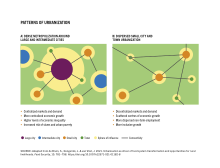
Different forms of urbanization can be classified depending on the style of architecture and planning methods as well as the historic growth of areas.
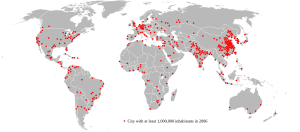
In cities of the developed world urbanization traditionally exhibited a concentration of human activities and settlements around the downtown area, the so-called in-migration. In-migration refers to migration from former colonies and similar places. The fact that many immigrants settle in impoverished city centres led to the notion of the "peripheralization of the core", which simply describes that people who used to be at the periphery of the former empires now live right in the centre.
Recent developments, such as
Rural migrants are attracted by the possibilities that cities can offer, but often settle in shanty towns and experience extreme poverty. The inability of countries to provide adequate housing for these rural migrants is related to overurbanization, a phenomenon in which the rate of urbanization grows more rapidly than the rate of economic development, leading to high unemployment and high demand for resources.[101] In the 1980s, this was attempted to be tackled with the urban bias theory which was promoted by Michael Lipton.
Most of the urban poor in developing countries unable to find work can spend their lives in insecure, poorly paid jobs. According to research by the Overseas Development Institute pro-poor urbanization will require labour-intensive growth, supported by labour protection, flexible land use regulation and investments in basic services.'[102]
Suburbanization
When the residential area shifts outward, this is called suburbanization. A number of researchers and writers suggest that suburbanization has gone so far to form new points of concentration outside the downtown both in developed and developing countries such as India.[103] This networked, poly-centric form of concentration is considered by some emerging pattern of urbanization. It is called variously edge city (Garreau, 1991), network city (Batten, 1995), postmodern city (Dear, 2000), or exurb, though the latter term now refers to a less dense area beyond the suburbs. Los Angeles is the best-known example of this type of urbanization. In the United States, this process has reversed as of 2011, with "re-urbanization" occurring as suburban flight due to chronically high transport costs.[104]
...the most important class conflict in the poor countries of the world today is not between labour and capital. Nor is it between foreign and national interests. It is between rural classes and urban classes. The rural sector contains most of the poverty and most of the low-cost sources of potential advance; but the urban sector contains most of the articulateness, organization, and power. So the urban classes have been able to win most of the rounds of the struggle with the countryside...
– Michael Lipton, author of urban bias theory[105]
Planned urbanization
Urbanization can be planned urbanization or organic. Planned urbanization, i.e.:
As population continues to grow and urbanize at unprecedented rates,
Water scarcity
Urbanization throughout the world
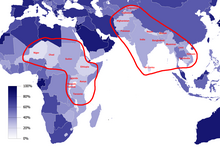
Presently, most countries in the world are urbanized, with the global urbanization average numbering 56.2% in 2020.[110] However, there are great differences between some regions; the nations of Europe, the Middle East, the Americas and East Asia are predominantly urbanized. Meanwhile, two large belts (from central to eastern Africa, and from central to southeast Asia) of very lowly urbanized countries exist, as seen on the map here. These labeled countries are among the least urbanized.
As of 2020, urbanization rates are over 80% in the United States, Canada, Mexico, Brazil, Argentina, Chile, Japan, Australia, the United Kingdom, France, Spain and South Korea. South America is the most urbanized continent in the world, accounting for more than 80% of its total population living in urban areas. It is also the only continent where the urbanization rate is over 80%.
See also
- Back to the land
- City-state
- Counterurbanization
- Division of labour
- Exurb
- Ghetto
- Human population planning
- Human migration
- Megalopolis (city type)
- Political demography
- Pseudo-urbanization
- Push and pull factors in migration
- Urban ecology
- Urban exploration
- Urban history
- Urban metabolism
- Urban morphology
- Urban studies
- Urbanization by country
- White flight
Historical
Regional
- Urbanization in Africa
- Urbanization in China
- Urbanization in India
- Urbanization in Pakistan
- Urbanization in the United States
References
- ^ "Urbanization". MeSH browser. National Library of Medicine. Archived from the original on 16 March 2016. Retrieved 5 November 2014.
The process whereby a society changes from a rural to an urban way of life. It refers also to the gradual increase in the proportion of people living in urban areas.
- ^ "Urbanization in". demographic partitions. Archived from the original on 22 October 2018. Retrieved 8 July 2015.
- OCLC 942419887.
- ^ "Urban life: Open-air computers". The Economist. 27 October 2012. Archived from the original on 5 September 2017. Retrieved 20 March 2013.
- ^ a b "Urbanization". UNFPA – United Nations Population Fund. Archived from the original on 26 May 2020. Retrieved 11 May 2015.
- ^ Barney Cohen (2015). "Urbanization, City Growth, and the New United Nations Development Agenda". Vol. 3, no. 2. Cornerstone, The Official Journal of the World Coal Industry. pp. 4–7. Archived from the original on 27 June 2015. Retrieved 26 June 2015.
- ISBN 978-1-4020-2531-0. Retrieved 22 March 2023.
- ISBN 978-1-000-42636-6. Retrieved 22 March 2023.
- doi:10.1002/jid.3104.
- .
- ISBN 5-484-01002-0. P. 44-62
- ^ "Urbanization over the past 500 years". Our World in Data. Archived from the original on 14 March 2020. Retrieved 6 March 2020.
- ^ S2CID 201674203.
- ^ Andrey Korotayev and Leonid Grini (2006). "The Urbanization and Political Development of the World System: A comparative quantitative analysis". In Peter Turchin; Leonid Grinin; Victor C. de Munck; and Andrey Korotayev (eds.). History & Mathematics: Historical Dynamics and Development of Complex Societies. Vol. 2. pp. 115–153. Archived from the original on 16 August 2021. Retrieved 23 June 2016.
- ^ "Industrial Revolution | Definition, History, Dates, Summary, & Facts". Encyclopedia Britannica. Archived from the original on 31 October 2020. Retrieved 29 October 2020.
- ^ CiteSeerX 10.1.1.522.7409.
- ISBN 978-0-8213-7573-0. Archived(PDF) from the original on 25 May 2017. Retrieved 9 November 2013.
- PMID 27271481.
- ^ "Research Data–Seto Lab". urban.yale.edu. Archived from the original on 18 May 2019. Retrieved 9 July 2016.
- ^ "The History of Urbanization, 3700 BC – 2000 AD". YouTube. Archived from the original on 30 October 2021. Retrieved 24 September 2018.
- ^ based on 2000 U.S. Census Data
- ^ a b Fuller, Thomas (5 June 2012). "Thai Youth Seek a Fortune Away From the Farm". The New York Times. Archived from the original on 5 June 2012. Retrieved 5 June 2012.
- PMID 22253992.
- ^ "Early Death Assured in India Where 900 Million Go Hungry". Bloomberg. 13 June 2012. Archived from the original on 14 June 2012. Retrieved 13 June 2012.
- ^ a b "Urbanization, gender and urban poverty:Paid work and unpaid carework in the city". UNFPA. 2012. Archived from the original on 22 July 2015. Retrieved 11 May 2015.
- hdl:10419/48738. Archivedfrom the original on 8 July 2017. Retrieved 9 November 2015.
- PMID 33597604.
- ^ KOSIS, Korean Statistical Information Service Archived 26 August 2013 at the Wayback Machine.(in Korean)
- (PDF) from the original on 24 June 2021. Retrieved 27 May 2020 – via core.ac.uk.
- ^ Benedictus, Leo (12 May 2017). "Blowing in the wind: why do so many cities have poor east ends?". The Guardian. Archived from the original on 12 May 2017. Retrieved 12 May 2017.
- ^ Grant, Ursula (2008) Opportunity and exploitation in urban labour markets Archived 18 September 2012 at the Wayback Machine London: Overseas Development Institute
- ^ Todaro, Michael P. (1969). "A Model of Labor Migration and Urban Unemployment in Less Developed Countries". The American Economic Review. 59 (1): 148.
- .
- ^ Brand, Stewart. "Whole Earth Discipline – annotated extract". Archived from the original on 15 January 2012. Retrieved 29 November 2009.
- S2CID 154678238.
- ^ Using the Gall-Peters Projection it is estimated that come 2015 the worlds urban population is set to exceed 4 billion, most of this growth is expected in Africa and Asia and China to be 50% urbanized.
- ^ "State of the World Population 2014". UNFPA. 2014. Archived from the original on 12 September 2018. Retrieved 11 May 2015.
- S2CID 199855869.
- ^ "Urbanization: An Environmental Force to Be Reckoned With". Archived from the original on 3 December 2019. Retrieved 19 July 2019.
- ^ Carbon Zero: Imagining Cities that can save the planet by Alex Steffen
- .
- ^ "World Economic and Social Survey (WESS) 2013" Archived 7 April 2014 at the Wayback Machine World Economic and Social Affairs. July 2013.
- ^ Auber, Tamar (17 July 2013) "Climate change and rapid urban expansion in Africa threaten children’s lives." Archived 13 November 2014 at the Wayback Machine UNEARTH News. Retrieved 10 August 2013.
- ^ Park, H.-S. (1987). Variations in the urban heat island intensity affected by geographical environments. Environmental Research Center papers, no. 11. Ibaraki, Japan: Environmental Research Center, The University of Tsukuba.
- ^ "Heat Island Effect" Archived 14 August 2015 at the Wayback Machine. Epa.gov (17 November 2010). Retrieved on 7 April 2014.
- ^ "Heating Up: Study Shows Rapid Urbanization in China Warming the Regional Climate Faster than Other Urban Areas". Archived from the original on 20 October 2019. Retrieved 31 July 2008.
- ^ "Runoff (surface water runoff)". USGS Water Science School. Reston, VA: U.S. Geological Survey (USGS). 6 June 2018.
- ^ Jiang, Leiwen; Hoepf Young, Malea; Hardee, Karen (2008). "Population, Urbanization, And The Environment". World Watch. 21 (5): 34–39.
- ^ "About Eutrophication | World Resources Institute". wri.org. 12 September 2013. Archived from the original on 19 November 2018. Retrieved 18 November 2018.
- ^ "Harmful Algal Blooms". US Environmental Protection Administration. 3 June 2013. Archived from the original on 4 February 2020. Retrieved 18 November 2018.
- ^ Ramesh, R; Lakshmi, A; Purvaja, R; Costanzo, S.D; Kelsey, R.H; Hawkey, J; Datta, A; Dennison, W.C (2013). "Eutrophication and Ocean Acidification" (PDF). Archived (PDF) from the original on 21 April 2021. Retrieved 18 November 2018.
- ^ a b "National Climate Assessment". National Climate Assessment. Archived from the original on 18 November 2018. Retrieved 18 November 2018.
- ISSN 0272-7714.
- ^ Fisheries, NOAA (9 September 2018). "Understanding Ocean Acidification | NOAA Fisheries". fisheries.noaa.gov. Archived from the original on 19 November 2018. Retrieved 18 November 2018.
- ^ "Ocean Acidification". Smithsonian Ocean. 30 April 2018. Archived from the original on 9 November 2020. Retrieved 18 November 2018.
- from the original on 27 December 2019. Retrieved 31 October 2018.
- ^ "Article: "Urban Food Waste generation: challenges and opportunities" Journal: Int. J. of Environment and Waste Management, 2009 Vol.3 No.1/2 pp.4 - 21 Abstract: Greater economic activity and a wider economic gap between rural and urban areas is leading to accelerated urbanisation and the generation of 35% more Urban Food Waste (UFW) from 2007 to 2025. Besides landfilling, this paper examines the advantages of introducing onsite composting and anaerobic digestion for the environmental recycling of UFW and the lowering of handling cost. For Asia and Africa, these solutions for UFW could reduce the mass of MSW by 43% and 55%, respectively, thus help there cities manage almost all of their MSW. For North America and Europe, such practice could reduce earth warming trends. - Inderscience Publishers - linking academia, business and industry through research". inderscience.com. Archived from the original on 1 November 2018. Retrieved 7 October 2018.
- ^ S2CID 34299202.
- (PDF) from the original on 26 July 2018. Retrieved 1 February 2019.
- ^ "Vector-borne diseases". World Health Organization. Archived from the original on 4 January 2023. Retrieved 19 October 2018.
- ^ EPA, OA, US (23 December 2015). "Overview of Greenhouse Gases | US EPA". US EPA. Archived from the original on 12 August 2016. Retrieved 16 October 2018.
- JSTOR 4401996.
- ^ ISSN 1543-5938.
- ^ Elmqvist, Thomas; Zipperer, Wayne; Güneralp, Burak (2016). "10". Urbanization, habitat loss, biodiversity decline: solution pathways to break the cycle. pp. 139–151.
- PMID 27124180.
- from the original on 27 February 2021. Retrieved 25 December 2020.
- ^ "Habitat Fragmentation and Wildlife Corridors" (PDF). Archived (PDF) from the original on 25 September 2022. Retrieved 11 July 2022.
- ^ "Habitat fragmentation – Practical considerations". Forest Research. Archived from the original on 24 September 2022. Retrieved 4 August 2022.
Features such as footpaths, rivers and canals already offer green corridors in many urban areas. Greenspace that is not suitable breeding habitat for many species may still serve to improve permeability, and therefore movement, between breeding sites.
- S2CID 23353943.
- PMID 35983686.
- ^ Lundkvist, E.; Landin, J.; Karlsson, F. (2002). "Dispersing diving beetles (Dytiscidae) in agricultural and urban landscapes in south-eastern Sweden". Annales Zoologici Fennici.
- .
- .
- ^ "In crowded Hlaing Tharyar township, slums sit next to gated communites (sic) | Coconuts Yangon". 22 February 2016. Archived from the original on 10 June 2016. Retrieved 27 May 2016.
- ^ from the original on 7 February 2020. Retrieved 20 September 2019.
- ^ PMID 18931915.
- PMID 26645285.
- ^ PMID 25217097.
- PMID 29135909.
- ProQuest 1013635534.
- PMID 26112265.
- ^ S2CID 46804746.
- S2CID 6018699.
- ^ S2CID 38066984.
- PMID 28283418.
- PMID 28858086.
- PMID 29317916.
- ^ Shelley, L. I. (1981). Crime and modernization: The impact of industrialization and urbanization on crime. Carbondale: Southern Illinois University Press.
- ^ Gumus, E. (2004). Crime in urban areas: An empirical investigation.
- ^ Bruinsma, G. J. (2007). Urbanization and urban crime: Dutch geographical and environmental research. Crime and Justice, 35(1), 453-502.
- ^ Malik, A. A. (2016). Urbanization and Crime: A Relational Analysis. J. HUMAN. & Soc. Scl., 21, 68-69.
- ^ PMID 26327514.
- ^ PMID 23083085.
- ^ PMID 15570145.
- ^ PMID 25574386.
- ^ PMID 22311885.
- S2CID 37122169.
- PMID 18093463.
- PMID 21180479.
- PMID 29212385.
- S2CID 155010637.
- ^ "Opportunity and exploitation in urban labour markets" (PDF). Overseas Development Institute. November 2008. Archived from the original (PDF) on 27 March 2009. Retrieved 12 January 2009.
- .
- ^ Bora, Madhusmita (1 July 2012). "Shifts in U.S. housing demand will likely lead to the re-urbanization of America". Nwitimes.com. Archived from the original on 26 September 2017. Retrieved 20 March 2013.
- ^ Varshney, A. (ed.) 1993. "Beyond Urban Bias", p. 5. London: Frank Cass.
- ^ Lwasa, Seto, Shauib, Karen (27 November 2021). "Chapter 8 Urban Systems and other Settlements" (PDF). Archived (PDF) from the original on 4 April 2022. Retrieved 4 April 2022.
{{cite web}}: CS1 maint: multiple names: authors list (link) - ^ Christopher B. Leinberger; Patrick Lynch (2014). Foot Traffic Ahead: Ranking Walkable Urbanism in America's Largest Metros (PDF) (Report). The George Washington University School of Business. Archived from the original (PDF) on 24 September 2015. Retrieved 11 July 2015.
- .
- ^ "Publication CRAPU | Université Quisqueya". uniq.edu.ht. Retrieved 29 September 2023.
- ^ "UN: How has the world's urban population changed from 1950 to 2020?". World Economic Forum. 4 November 2020. Archived from the original on 31 October 2022. Retrieved 31 October 2022.
Further reading
- Armus, Diego; Lear, John (1998). "The trajectory of Latin American urban history". Journal of Urban History. 24 (3): 291–301. S2CID 144282123.
- Bairoch, Paul. Cities and economic development: from the dawn of history to the present (U of Chicago Press, 1991). online review
- Goldfield, David. ed. Encyclopedia of American Urban History (2 vol 2006); 1056pp; Excerpt and text search
- Hays, Samuel P (1993). "From the History of the City to the History of the Urbanized Society". Journal of Urban History. 19 (1): 3–25. S2CID 144479930.
- Hoffmann, Ellen M., et al. "Is the push-pull paradigm useful to explain rural-urban migration? A case study in Uttarakhand, India." PloS one 14.4 (2019): e0214511. online
- Lees, Andrew. The city: A world history (New Oxford World History, 2015), 160pp.
- McShane, Clay. "The State of the Art in North American Urban History," Journal of Urban History (2006) 32#4 pp 582–597, identifies a loss of influence by such writers as Lewis Mumford, Robert Caro, and Sam Warner, a continuation of the emphasis on narrow, modern time periods, and a general decline in the importance of the field. Comments by Timothy Gilfoyle and Carl Abbott contest the latter conclusion.
External links
- World Urbanization Prospects, the 2014 Revision, Website of the United Nations Population Division
- Urbanization in Bulgaria
- NASA Night Satellite Imagery – City lights can provide a simple, visual measure of urbanization
- Geopolis: research group, University of Paris-Diderot, France
- The Natural History of Urbanization, by Lewis Mumford
- The World System urbanization dynamics, by Andrey Korotayev
- Brief review of world socio-demographic trends includes a review of global urbanization trends
- World Economic and Social Survey 2013, United Nations Department of Economic and Social Affairs.

